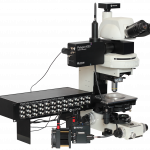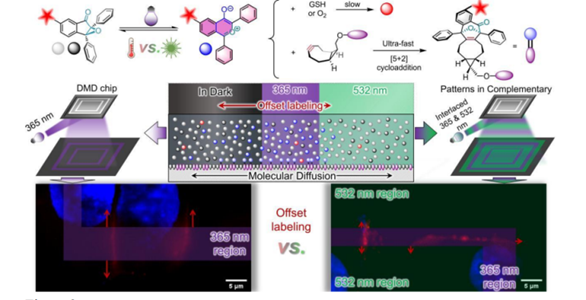Published on 2024/01/30 Research powered by Mightex’s Polygon 

Xinyu Xie, Fuqiang Hu, Yuqiao Zhou, Zhihao Liu, Xin Shen, Jielin Fu, Xiaohu Zhao & Zhipeng Yu, Interleaved complementary dual-λ photo-stimulation facilitates high spatial-temporal precision labeling. College of Chemistry, Sichuan University, (2023).


The photo-click chemistry combines the concepts of “click” chemistry and “photo-controlled” reactions in a single system. It inherits the high spatiotemporal resolution of a photo-controlled reaction and can be widely used for the lithographic surface functionalization of bio-based interfaces, for in situ 3D photo-printing of biomaterials and for labeling and tracking of biomolecules in native cellular environments. In conventional photo-click strategies, due to a reasonable life-time of the highly reactive species in aqueous medium, they would eventually undergo many competitive side-reactions in complex biological environments, and also due to the constant molecular diffusion of the reactive species leads to off-site ligation lagging behind the irradiation events. Herein, we have developed a novel type of bioorthogonal ligation approach by utilizing a tailored photoswitchable molecular (DIO) as a photo-click reagent couple with the immobilized reporter molecules. By exposure to 365 nm light, DIO was converted to highly reactive PY and the color of the solution changed to an intense rose-red. On the other hand, as a set of molecular photoswitches, PY rapidly back-switched to DIO upon green light irradiation, thus shutting down its reactivity. Irradiation of DIO solutions with stirrers by interlaced complementary 365/520 nm beams shows spaced rose-red streaks, indicating that it is possible to compensate for molecular diffusion via dual-wavelengths photo-modulation at the macroscopic level (Fig. 1a).
Our next step was to apply this interlaced complementary illumination to microscopy techniques. To do this, we used the Mightex Polygon 400 DMD system to realize focally illumination with STED-like techniques. Firstly, we attempted that the DIO-based photo-click reaction is capable of covalently functionalizing of material surface via lithographic fabrication techniques. A designated pattern in 365 nm was projected onto the coverslip to switch on PY with Cy3 fluorophore for conjugation toward the immobilized reporter molecular within the patterned region, and a complementary pattern in 525 nm was followed to switch off diffused PY to avoid blurring of imprinted shape. The cycled dual-λ photo-stimulation sequence was programmed in the Polyscan 2 software (Mightex) by subdividing the whole 20 s 365 nm stimulation into 60 cycles. In each cycle, duration of the 365 nm stimulation was set to be 500 ms, which was appended with a 525 nm stimulation pattern in complementary to the designated pattern within the stimulation field for 500 ms with an output power of 80% of a 1.3 W LED (light power) (Fig. 1b). After washing to remove unreacted probe, two individual fluorescent imprints can be imaged in Cy3 channel, displaying high-contrast shapes with submicron resolution (Fig. 1c).

Figure 1.
A pattern of a Chinese character “hui” was then applied to the cell membrane labeling by a similar illumination sequence. In a spatial dimension, the interlaced and complementary dual-λ photo-stimulation was proven to be effective in restricting the distribution of reactive PY in designated regions via dynamic switching to counteract the molecular diffusion. Thanks to the Mightex Polygon 400 DMD System, the photo-decoration of bioorthogonal reporters on living cell membranes can be elaborated on submicron level (Fig.2).
 Figure 2.
Figure 2.
Author: Xinyu Xie
Bio: College of Chemistry, Sichuan University, China



